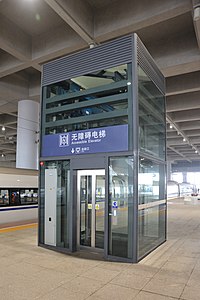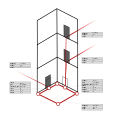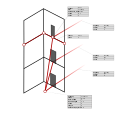Tag:highway=elevator
 |
| Description |
|---|
| An elevator (or lift) is used to travel vertically, providing passenger and freight access between pathways at different floor levels. May be solely vertical (typical case) or inclined. |
| Rendering in OSM Carto |
| Group: highways |
| Used on these elements |
| Useful combination |
|
| See also |
| Status: de facto |
| Tools for this tag |
An elevator (or lift) is used to travel vertically, providing passenger and freight access between pathways at different floor levels.
How to map as a node
Add a node to the location of the elevator and tag it with highway=elevator.
How to map as an area
With detailed indoor mapping, some elevators (majority of ones mapped on ways and closed ways) are mapped as an area representing elevator and tagged with highway=elevator. Add area=yes to clearly distinguish them from inclined elevators.
Additionally create separate node(s) ![]() tagged with
tagged with indoor=door or entrance=* and repeat_on=* for the elevator's door(s). The node(s) should be part of the highway=elevator area to make it clear for data consumers that the door(s) belong to the elevator. It is also recommended to add door=* and automatic_door=* to the node(s).
How to map as a way
Inclined elevators
Inclined elevators (sometimes known as inclinators) are mapped as an open way between both endpoints. In this case, the way itself is tagged with highway=elevator.
The endpoints can be tagged with their corresponding level=* and door=* for indoor tagging.
An example how it can be mapped.
See also railway=funicular and Inclined elevator on Wikipedia
Elevator dimensions
The dimensions always refer to the cage and not to the elevator's building (building=elevator) or hoistway (indoor=room). They are useful for cyclists, wheelchair users, people transporting goods, etc. to know for example whether something fits through the doors, or someone can turn around inside the elevator.
| Tag | Description |
|---|---|
height=*
|
Total measurement in the direction perpendicular to the floor. Also known as the inner height of the cage. |
maxheight:physical=*
|
Maximum usable height that is available across the whole area of the elevator. This means the base height=* minus any obstructions reaching into the elevator cabin, like a lamp.
|
Basic elevators

For elevators mapped as ![]() or incline elevators the door and cage dimensions can be tagged via the following keys:
or incline elevators the door and cage dimensions can be tagged via the following keys:
| Tag | Description |
|---|---|
door:width=*
|
Inner width (clear width) of the entrance/exit. |
door:height=*
|
Inner height (clear height) of the entrance/exit. |
Rectangular shaped elevator
| Tag | Description |
|---|---|
length=*
|
Total measurement of the floor in the direction someone enters or exits the elevator. Usually understood as the depth of the elevator. |
width=*
|
Total measurement of the floor perpendicular to the direction someone enters or exits the elevator. |
maxlength:physical=*
|
Maximum usable space in the direction someone enters or exits that is available on the whole height of the elevator. This means the base length=* minus any obstructions reaching into the elevator cabin, like handrails or control consoles.
|
maxwidth:physical=*
|
Maximum usable space perpendicular to the direction someone enters or exits that is available on the whole height of the elevator. This means the base width=* minus any obstructions reaching into the elevator cabin, like handrails or control consoles.
|
Circular shaped elevator
| Tag | Description |
|---|---|
diameter=*
|
Distance between the elevator walls measured through the center of the elevator. The presence of diameter=* implies that the elevator has a circular shape so shape=circular can be omitted. Note that the diameter=* unit defaults to mm.
|
maxdiameter:physical=*
|
Maximum usable space between the elevator walls measured through the center that is available on the whole height of the elevator. This means the base diameter=* minus any obstructions reaching into the elevator cabin, like handrails or control consoles. Note that the maxdiameter:physical=* unit defaults to mm.
|
Special elevators
- elevators with doors on adjacent sides[1] (mainly required because width and length become ambiguous)
- elevators with different doors regarding dimensions, mechanisms, etc.
- specially shaped elevators
In any of these cases map the elevator as an ![]() as described in the above section. Tag the door dimensions by adding
as described in the above section. Tag the door dimensions by adding width=* and height=* to the door node(s).
In rare cases the stationary doors in the hoistway wall on each level (outer doors) can differ from the door(s) that is part of and moves with the elevator cabin (inner door). Possible differences are the door size (width=*/height=*), whether it has to be opened manually (automatic_door=no) or if it requires a key (locked=yes). As with the other tags, this is relevant so routing engines can decide whether a person may or may not be able to leave the elevator at a particular level.
In such case map the hoistway wall (indoor=wall unless the wall is already described by an adjoining element like indoor=room) for the particular level and its respective door (indoor=door). The outer door ![]() should be connected to either the inner door
should be connected to either the inner door ![]() or the elevator via a
or the elevator via a highway=footway or highway=path ![]() .
.
Examples
-
Elevators with doors on adjacent sides
-
Outer doors with different dimensions or different type
Access Examples
Tags to use in combination
access=yes/no/private/customers...bicycle=yes/nocapacity:persons=*– capacity (persons); please make sure to use capacity:person (singular) as key, because the other extensions of the key capacity are built like this, too. Some mappers do also use justcapacity=*fort this.contact:website=*– (such as for its current status)fee=yes/no– does a fee have to be paid?goods=yes/no/designated– a freight elevator? NOTE: Forhighway=*features,goods=*means legal access restriction for goods vehicles. Consider other tagging (e.g.,handcart=*,handtruck=*) if the elevator is for goods carried by person, not by vehicle, to avoid confusion.handrail=yes/no– is there a handrail inside the elevator cabin?indoor=*– within a building?level=*– storey/floor; example:level=-1;0;1;2– an elevator that goes all the way from the basement to the 2nd floormanufacturer=*– manufacturer (such as Otis)maxweight=*– maximum weight (in metric tons)tactile_writing:braille:XX=yes/no, where XX is a language code, for exampledefor Germanoperator=*ref=*– reference id, given by the manufacturerstart_date=*– opening/inauguration (year)surveillance=indoor/outdoor– camera surveillance?opening_hours=*wheelchair=yes/no– suitable for wheelchairs?
Funicular vs inclined elevator

The difference between short funicular (tagged as railway=funicular) and inclined elevator (tagged as highway=elevator way) is not always obvious.
- Montmartre Funicular was constructed as a funicular, was rebuild into a double inclined elevator – but still has “funicular” in name and difference is quite subtle. Mapped as a funicular. Cars are no longer counterbalanced, so it is no longer a true funicular.
- Some have a driver inside them There is a single car, so it is not a true funicular.
- Some act and look exactly like a normal elevator (no operator, the same design, elevator arrives at button press etc.)
See also
- OpenTripPlanner elevator tag usage
- elevator on Wikipedia
elevator=yes/no- Proposal:Elevator dimensions
- ↑ Elevator with doors on adjacent sides https://www.youtube.com/watch?v=3A4pou9L3cU






